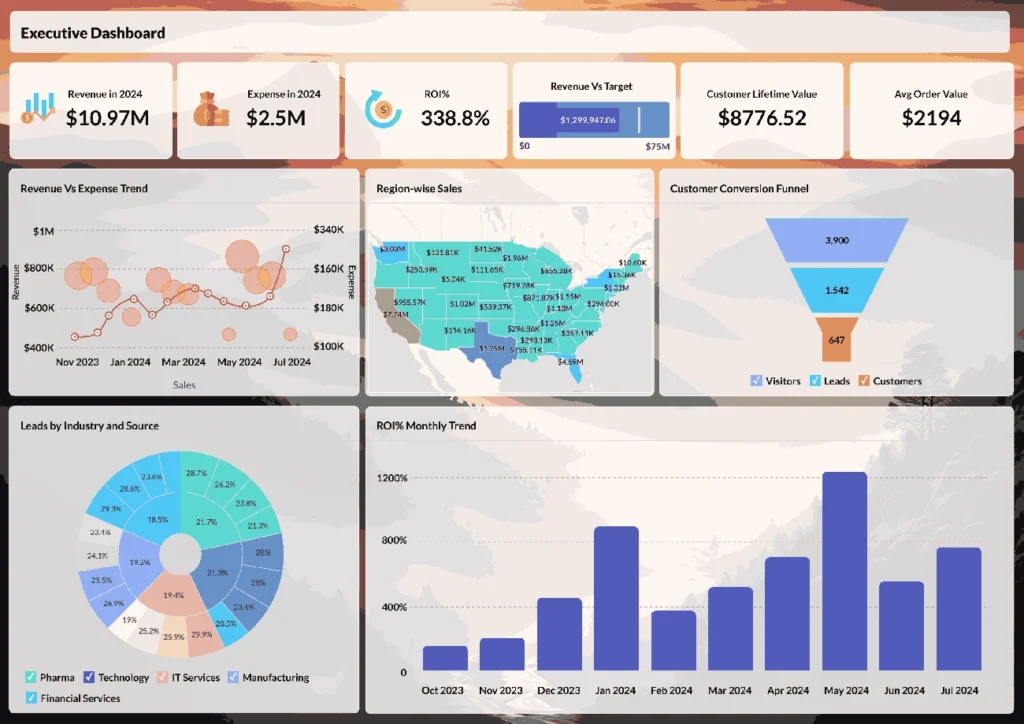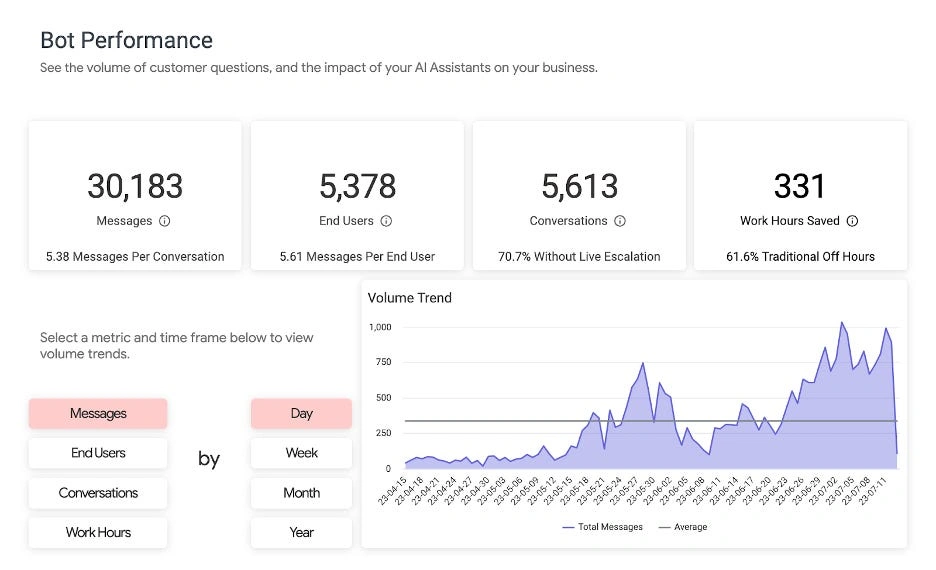How to Build Your AI Implementation Strategy: A Practical Guide for Business Results

Organizations worldwide have already implemented AI at a rate of 78%, and global spending will reach nearly $644 billion by 2025.
This rapid growth presents business leaders with a significant challenge: proving clear return on investment from their AI initiatives. Companies consider value achievement their primary concern when implementing AI, with 49% citing it as their top priority. ROI from generative AI averages only 6%, though 74% of organizations report positive returns.
Business discussions now focus on “How do we use AI effectively?” rather than “What if we used AI?” A strategic framework for AI implementation helps organizations succeed. Your company needs a well-laid-out AI implementation strategy to secure ROI, whether you want to start a journey with enterprise AI or boost existing systems.
This piece provides a roadmap to build an AI implementation strategy that delivers measurable business results. We help you transform AI from a buzzword into a genuine business asset by defining ROI metrics and highlighting common pitfalls to avoid.
Define the ROI of AI for Your Business

Image Source: Zoho
ChatGPT’s release three years ago sparked high expectations, but the Forbes Research 2025 AI Survey paints a different picture. Only 1% of C-suite executives reported a 20%+ increase in profitability from AI investments. The numbers show 53% saw minimal returns between 1-5%. These findings highlight the gap between AI’s promise and actual business returns.
What makes AI ROI different from traditional ROI
Standard ROI calculations work great for equipment or process improvements but miss the mark on AI’s true value creation. AI initiatives don’t follow the predictable paths of conventional investments.
AI investments grow and evolve. The models get better as they learn from more data and situations, which creates growing value instead of depreciation. The returns aren’t guaranteed – you get better forecasts and faster decisions rather than fixed outcomes.
AI touches many parts of business at once, which makes tracking its exact contribution tough. Many leaders say AI brings benefits that are hard to calculate in pure dollars. Simple before-after comparisons miss the long-term value that AI creates.
The formula to calculate AI ROI
The simple ROI formula remains a financial ratio of gain to cost:
ROI (%) = (Net Benefit / Total Cost) × 100
A detailed AI ROI calculation must include:
- Costs: Development environment, implementation expenses (tools, training, advisory services), ongoing operations (maintenance, updates, monitoring), data cleaning, model training, governance structures
- Benefits: Direct financial gains (automation-driven cost savings, revenue increases) and indirect benefits like better decisions, customer experience improvements, and innovation capabilities
The unique nature of AI needs both hard ROI (measurable gains like cost savings) and soft ROI (quality improvements like customer satisfaction). PwC’s research shows hard ROI comes from saved time, better productivity, lower costs, and revenue growth.
Why ROI must be tied to business outcomes
Success with AI starts by looking at your business goals. AI creates value only when it helps achieve what your business needs. Projects without clear business targets often stall before showing real results.
Look at your current KPIs first, processing times, error rates, customer satisfaction scores. Then project how AI could change these numbers. The Enterprise Strategy Group found that adding AI to customer experience and ERP systems can bring a 214% ROI over five years. This number jumps to 761% with maximum improvements.
Your measurement system should track efficiency (time saved, automated processes), quality (fewer errors, better decisions), capabilities (new tasks, enhanced skills), and strategy (market edge, faster innovation).
Getting returns from AI needs a deep grasp of your business processes and metrics. Your AI strategy will succeed when you connect it to strategic goals and focus on what matters most to your business.
Build Your AI Implementation Strategy Framework
A successful AI implementation strategy needs more than excitement about new tech. Studies show that 80% of AI projects fail or are headed that way. Companies need a clear framework to turn their AI investments into measurable business outcomes.
Start with a clear business problem
Success with AI starts by finding specific business challenges that AI can solve. Business leaders have less than 18 months to execute their AI strategy before facing negative results. Starting with tech instead of business needs will lead to poor outcomes.
The first step is to review your processes and find measurable pain points where AI could cut costs, boost speed, improve quality, or help customers. You should ask: What problems need fixing? How can AI make customer experiences better? Which decisions could AI automate?
To cite an instance, if your packaging line faces delays because of inconsistent quality checks, AI-driven quality control could add value here. This way, your AI project tackles real needs instead of becoming a solution looking for a problem.
Line up AI goals with company strategy
Your AI strategy must fit with your bigger business goals. AI strategy accelerates business strategy by supporting the same key performance indicators that give competitive edge. Business goals shape the AI direction, while new AI capabilities can influence where the business goes.
Companies that scale better and create more value focus on connecting strategic priorities from their main business plan to specific AI areas where they should invest. These areas could be departments, core products, or complete processes like customer experiences.
C-level stakeholders should help develop an AI vision that matches your company’s business goals and market position. This team approach will give AI projects that support key priorities rather than running separately.
Secure buy-in from finance, IT, and strategy leaders
Leadership support is vital to scale AI solutions – research shows only 54% of AI projects move from pilot to production. Teams across functions must support each other as AI changes systems, processes, and roles.
Your strategic blueprint should show company goals alongside risks and benefits of your AI solution. When you present to leaders:
- Explain what the solution can do
- Show which business areas fit implementation best
- Draw simple diagrams of AI structure and data use
- Show how AI fits your current business model
Digital change is ongoing, not a one-time event. Professor Tsedal Neeley puts it well: “You’re in a perpetual state of transitioning… Technology changes. Data changes. The ecosystem changes.”
Use pilot projects to verify assumptions
Test your AI strategy through small pilot projects before full rollout. This approach cuts risks while you learn what the technology can do. Pilots give you a safe space to check AI’s effects, get more support from stakeholders, and let teams learn hands-on.
Pick pilot projects that target your biggest inefficiencies. Make sure these pilots match long-term goals, if you plan to enter new markets, an AI system that predicts equipment failures could help increase production.
Set clear success metrics before launching pilots, both for technical performance and business results. Check progress often during implementation and adjust based on what works. This step-by-step approach builds a strong base for wider AI use while teaching valuable lessons to improve your strategy.
Set Metrics and Track ROI Over Time

Image Source: The Father Gap – Substack
A systematic approach helps measure AI’s business impact over multiple time periods. Global studies show organizations get back USD 3.50 for every USD 1.00 they put into AI. Top performers see even better returns of USD 8.00 per dollar. In spite of that, this value takes about 14 months after the first implementation to show up.
Short-term: Efficiency and cost savings
AI’s quick benefits show up as operational efficiencies. These “hard ROI” metrics boost profitability within months. Key measurements include:
- Lower labor costs through automation and better output
- Better operations from efficient processes
- Faster processing, especially for routine tasks
- Fewer errors and better accuracy
To name just one example, an AI-powered fraud detection system cuts down false positives. This eliminates extra investigations and lets analysts do more valuable work.
Mid-term: Revenue lift and customer impact
Your AI system’s value grows over time. These metrics matter most six to twelve months after launch:
AI content scoring should split between revenue metrics at 60% and quality of engagement at 25%. Click-through rates, session lengths, and Net Promoter Scores show how AI improves user experience.
Long-term: Innovation and market share
Strategic benefits become clear after two years. McKinsey reports generative AI could add USD 2.60 trillion to USD 4.40 trillion yearly to the global economy. Long-term tracking should look at:
Bigger market share, faster market entry, and new intellectual property prove AI’s lasting effect. These numbers also reveal your company’s speed at inventing and growing compared to others.
Key metrics to track: productivity, error reduction, AI-attributed revenue
Some basic metrics stay important throughout your AI trip:
Productivity metrics: Staff output grows as people focus on valuable work. Research shows AI might automate 60-70% of current work activities.
Error reduction: Accuracy gets better, especially in vital areas like processing documents or talking to customers.
AI-attributed revenue: Smart attribution models track and credit AI touchpoints. This works better than old single-touch or multi-touch methods.
Note that AI creates growing value instead of losing worth over time. Tracking these metrics across different periods gives you a detailed view of how your AI strategy affects business results.
Avoid Common Pitfalls in AI Implementation
AI projects face roadblocks that can derail even the most promising initiatives. Recent studies show that nearly 88% of AI projects fail to reach production. These projects often stumble on challenges that teams could have seen coming. Let’s get into the biggest problems that successful AI implementation strategies need to address.
Underestimating hidden costs
AI costs go way beyond the original implementation. Computing costs will likely jump 89% between 2023 and 2025. Executives point to generative AI as the driving force behind this increase. The situation looks grim as all executives surveyed had to cancel or delay at least one generative AI project because of budget concerns.
Complex models lead to escalating expenses. Data increases tenfold make computing costs rise a hundredfold. Technical debt creates another hidden cost. Poorly documented code and rushed deployments become more expensive as systems grow.
Poor data quality and readiness
Data professionals (96%) warn that poor data quality could trigger widespread crises. This basic issue doesn’t get enough attention. Yes, it is true that 81% of companies face major data quality issues in their AI initiatives. Leadership doesn’t seem to care about these problems according to 85% of professionals.
Bad data leads to many problems. Models become inaccurate and outputs show bias. Hallucinations occur when models trained on generic data perform poorly on specific datasets. AI systems use probabilistic models instead of deterministic data systems. This means they need different data preparation methods than traditional technologies.
Lack of integration with core workflows
Companies find integration the toughest part of adopting AI. Legacy data systems move slowly and make models useless. The current infrastructure can’t handle immediate predictions or continuous data streams that modern AI needs.
AI becomes an expensive add-on without proper workflow integration. It fails to transform the business. About 75% of employees say generative AI tools reduced their productivity and added work. This happens because companies don’t adapt their processes to work with new AI capabilities.
Overpromising results without validation
Unrealistic expectations lead to disappointment and lost trust. Organizations often pick metrics that only show model accuracy. They miss other critical factors that determine success. Executives often miss data quality issues. Non-management employees (27%) spot major AI data quality problems more often than executives (17%).
Skipping validation phases sets AI projects up to fail. This explains why companies will abandon one-third of enterprise generative AI projects after the pilot phase in 2025. Teams should validate through careful testing and scenario planning before full deployment. This helps ensure AI meets real business needs.
Scale AI for Long-Term Business Value
AI projects must grow from experiments into company-wide assets. Studies show 70-90% of AI pilots never reach production. This creates a huge waste of resources. Companies need a well-planned approach to scale beyond what BCG calls “pilot purgatory”.
Move from pilots to enterprise AI implementation strategy
Start by looking at your pilot results to spot gaps, limits, and what works well. These findings are the foundations of a complete roadmap that puts business goals first, not technology. The numbers tell a clear story – companies that scale AI well see 3x more revenue and 30% higher EBIT than those stuck in the pilot phase.
Invest in MLOps and continuous monitoring
MLOps (Machine Learning Operations) creates a space where AI delivers business value by building, testing, and deploying ML technology quickly. Using MLOps best practices makes a huge difference in what teams can achieve. It’s “the difference between experimenting with AI and reshaping your company’s competitive position”.
The core parts include:
- Automated data pipelines that give quality and availability
- Model version control and continuous integration
- Performance monitoring to check data drift and accuracy
Enable cross-functional ownership
AI projects need more cross-functional expertise than traditional ones. The core team’s ownership turns compliance from a checklist into active governance. Teams should mix data scientists, engineers, product managers, and business stakeholders. Each member brings a unique view to boost decision-making.
Plan for ongoing breakthroughs and retraining
AI models get worse as data changes. Banking models showed poor performance during unexpected events like the pandemic – 35% failed without retraining. Teams should build continuous learning through automated monitoring systems that watch metrics and start retraining when performance drops. This cycle helps AI adapt to changing business needs rather than becoming outdated.
Conclusion
A successful AI strategy goes beyond just adopting new technology, it creates real business value. This piece explores how winning AI projects need clear ROI definitions and proper arrangement with business goals. Companies also need thoughtful frameworks to make implementation work.
The experience of moving from small projects to company-wide changes takes time and careful planning. Your organization should understand that AI investments work differently than traditional ones. They grow in value over time instead of losing worth.
Companies that get soaring wins from AI focus on fixing specific business problems. They get support across departments and set up strong measurement systems. On top of that, they stay away from common mistakes. These include underestimating hidden costs, poor data quality, and failure to blend AI with daily work processes.
Your success ended up depending on scaling beyond test projects while you retain control of monitoring and retraining systems. This approach will give your AI assets room to grow as business needs change. We suggest you follow Business Intelligence Edge Newspaper to stay informed about AI implementation practices and new trends.
The change from asking “What if we used AI?” to “How do we use AI effectively?” shows how enterprise AI has grown up. Companies that become skilled at this change – and measure effects across different time periods – will turn AI from an experiment into a lasting competitive edge.
Key Takeaways
Building a successful AI implementation strategy requires moving beyond technology enthusiasm to focus on measurable business outcomes and strategic alignment.
• Start with specific business problems, not AI capabilities – 88% of AI projects fail when technology leads strategy instead of solving real challenges.
• Calculate AI ROI differently than traditional investments – AI creates compounding value over time rather than depreciation, requiring dynamic measurement approaches.
• Secure cross-functional buy-in from finance, IT, and strategy leaders early – only 54% of AI pilots reach production without proper stakeholder alignment.
• Track metrics across three timeframes: short-term efficiency gains, mid-term revenue impact, and long-term innovation capabilities for comprehensive value assessment.
• Invest in MLOps and continuous monitoring to scale beyond pilots – companies that effectively scale AI achieve 3x higher revenue impacts than those stuck in “pilot purgatory.”
The key to AI success lies in treating it as a strategic business transformation rather than a technology project, with clear measurement frameworks and ongoing adaptation to changing business needs.
FAQs
Q1. What is an AI implementation strategy? An AI implementation strategy is a comprehensive plan that outlines how an organization will integrate artificial intelligence technologies to solve specific business problems and achieve measurable outcomes. It involves aligning AI initiatives with overall business goals, securing cross-functional buy-in, and establishing frameworks for measuring ROI across different time horizons.
Q2. How do you calculate ROI for AI projects? Calculating ROI for AI projects requires a different approach than traditional investments. The basic formula is (Net Benefit / Total Cost) × 100, but it should include both direct financial gains and indirect benefits. Consider efficiency metrics, quality improvements, new capabilities enabled, and strategic advantages. Remember that AI often creates compounding value over time rather than depreciating.
Q3. What are common pitfalls in AI implementation? Common pitfalls in AI implementation include underestimating hidden costs, poor data quality and readiness, lack of integration with core workflows, and overpromising results without proper validation. Organizations often struggle with scaling beyond pilot projects and fail to implement continuous monitoring and retraining systems necessary for long-term success.
Q4. How can businesses move from AI pilots to enterprise-wide implementation? To move from pilots to enterprise-wide implementation, businesses should evaluate pilot results to identify successful patterns and limitations. Develop a comprehensive roadmap focused on business goals rather than technology. Invest in MLOps (Machine Learning Operations) for efficient building, testing, and deployment of AI. Enable cross-functional ownership and plan for ongoing innovation and model retraining.
Q5. What metrics should be tracked to measure AI success? Key metrics to track AI success include short-term efficiency gains and cost savings, mid-term revenue lift and customer impact, and long-term innovation and market share improvements. Specific metrics might include productivity increases, error reduction rates, AI-attributed revenue, processing time reductions, and customer satisfaction scores. It’s important to measure impact across different time horizons for a comprehensive view of AI’s business value.



